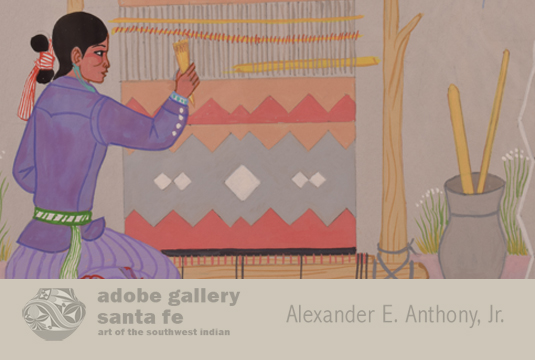Original Painting of Navajo Weaver with Loom [SOLD]
+ Add to my watchlist Forward to Friend
- Category: Paintings
- Origin: Diné of the Navajo Nation
- Medium: watercolor
- Size:
10-½” x 8-¾” image;
17-¼” x 15-1⁄2” framed - Item # C4192B SOLD
According to myth, a holy being called Spider Woman brought weaving to the Diné. The first loom was formed by harnessing the power of the sun to make the frame. The lashing cords came from lightning, and the warps from rain. After the creation of the loom, Spider Woman showed the Diné how to weave by using the tools of white shell and crystal. She showed them how to use this knowledge to make things that were both useful and beautiful.
In 1868, the Diné returned to their homeland after being incarcerated for five years at Bosque Redondo in Lincoln County New Mexico. Following their return, a network of US Government-licensed trading posts was established across the reservation. In exchange for their wool, sheep, jewelry, baskets and rugs, the Diné acquired coffee, sugar, flour and other goods which they were unable to produce on their own. This was the beginning of what would become an important part of the Diné economy: the sale of textiles to non-native people.
Early traders recognized the marketability of the Diné weavings, which were both attractive and functional. Traders encouraged the weavers with whom they worked to use patterns and designs that would be desirable to customers off the reservation. Mail order catalogs were printed, and the rugs were marketed worldwide. The weaving of rugs for outside sale became the primary source of income for some Diné families. Without the income from the sale of rugs, many families would have suffered greatly. It is because of this that weavers and the art of weaving are highly regarded and respected among the Diné.
![]() his painting by Harrison Begay (1917-2012) features a Diné woman weaving. The wonderful thing about this scene is that it allowed Begay a chance to play with colors and shapes that might not fit into other images. Here, he designed his own textile—a pastel-hued piece made of diamonds and triangles—and surrounded it with his typically charming presentation of Diné life. The painting is signed “Haskay Yahne Yah” in lower left, and “Harrison Begay” in lower right.
his painting by Harrison Begay (1917-2012) features a Diné woman weaving. The wonderful thing about this scene is that it allowed Begay a chance to play with colors and shapes that might not fit into other images. Here, he designed his own textile—a pastel-hued piece made of diamonds and triangles—and surrounded it with his typically charming presentation of Diné life. The painting is signed “Haskay Yahne Yah” in lower left, and “Harrison Begay” in lower right.
 Harrison Begay (1917-2012) was a world-renowned Diné (Navajo) painter who is generally regarded as one of the most successful and influential early Native American painters. Begay studied under Dorothy Dunn at the Santa Fe Indian School in the 1930s, and then attended colleges in North Carolina and Arizona. From 1942 to 1945, he served in the US Army Signal Corps. In 1947, Begay returned to the Navajo reservation, where he enjoyed a long and productive career as a painter. He is known to have continued painting into his 90s. Begay passed away in 2012.
Harrison Begay (1917-2012) was a world-renowned Diné (Navajo) painter who is generally regarded as one of the most successful and influential early Native American painters. Begay studied under Dorothy Dunn at the Santa Fe Indian School in the 1930s, and then attended colleges in North Carolina and Arizona. From 1942 to 1945, he served in the US Army Signal Corps. In 1947, Begay returned to the Navajo reservation, where he enjoyed a long and productive career as a painter. He is known to have continued painting into his 90s. Begay passed away in 2012.
Condition: this Original Painting of Navajo Weaver with Loom is in excellent condition
Provenance: from the collection of a resident of Arizona
Relative Links: Diné - Navajo, Harrison Begay, Dorothy Dunn, Native American Paintings

- Category: Paintings
- Origin: Diné of the Navajo Nation
- Medium: watercolor
- Size:
10-½” x 8-¾” image;
17-¼” x 15-1⁄2” framed - Item # C4192B SOLD



